Arado Ar-196. Kriegsmarine eyes
3 December 1939, the German “pocket” battleship Admiral Graf Spee, who raided the waters of the South Atlantic, collided with a squadron of British cruisers. Having been damaged during the battle, the battleship, after Uruguay’s refusal to provide harbor for repairs, was flooded so as not to get to the British, and the team was interned. Together with the "Earl of Spee" went to the bottom and his ship reconnaissance - float "Arado" Ar-196. So ended story this pocket battleship, the first of the Kriegsmarine ships to receive a new seaplane before the start of their last voyage. Before his death in the harbor of Montevideo, the Admiral Count Spee seriously annoyed the British, having managed to sink eleven merchant ships, while the main role in the search for victims of the battleship was played by his air reconnaissance aircraft.
After the end of the First World War and until the mid-thirties, the Heinkel company was considered the main producer of float-operated seaplanes in Germany. In 1931, Heinkel built a fairly successful double float biplane, the Non-60, the latest modifications of which, along with the heavier twin-engined seaplane, the Non-51, were part of the infamous Legion Condor and fought in Spain.
In 1935, the company proposed that the German Navy replace the Non-60 with the non-114 plan. However, tests of several prototypes of the Non-114 VI with the Yumo engines revealed very weak flight and hydrodynamic qualities of the new machine. In fact, its characteristics remained at the level of its predecessors. For limited use, ordered three dozen aircraft of this type with 12-cylinder engines Yumo 210 and 45 copies - with radial 9-cylinder engines BMW 132. Subsequently, most of them were in service with the allied countries of Germany.
In the second half of the thirties, “Heinkel” did not have the best of times - its monopoly on the construction of seaplanes was over, since the fleet and the ministry aviation announced increased requirements that the new ejection double seaplane had to meet, and a competition for its development. Well-known companies fought for receiving an order for the mass production of such a machine: Dornier, Arado, Focke-Wulf and Gotha-Wagon-factories. Moreover, each contestant was required to submit an aircraft project in two versions (one and two-float) using BMW 132KV engines. But Heinkel, reassured by a small order for the He-114, did not take part in the competition.
In the autumn of 1936, there were two main candidates among the applicants - “Arado” and “Focke-Wulf”. Having learned about the success of their project, the engineers of Arado accelerated the pace of work on prototypes in order to have time to fly around them in the summer of 1937. Not lagged behind and competitors from the “Focke-Wulf.” Having met the required deadlines, Arado prepared four prototypes: Аr-196 V1, Аr-196 V2 with two floats (prototypes of the future “A” series) and Аr-196 V3, Аr-196 V4 with one float (prototypes V1, Аr-1 V1 with one float (prototypes V1, Аr-62 VXNUMX with one float (prototypes VXNUMX, Аr-XNUMX VXNUMX with one float (prototypes of the A series)) AT"). On the fuselage and the wings of the first caused the code "D-XNUMXENK" and "D-XNUMXНOXNUMX", and the second - "D-XNUMXLRE" and "D-OVМВ". The Focke-Wulf company was offered to build only two copies of its FW-XNUMX biplane, using them as a fallback, deservedly considering the Arado project with one low-lying wing more promising.
The first test flights of prototypes took place in Travemünde. On the Ar-196 V4 installed a complete set of on-board armament, which included two 20-mm guns MG FF "Oerlikon" with 60 ammunition shells and 7,92-mm MG 17 machine gun with 500 cartridges for it. The guns were in the center section of the wing, and the machine gun - on the right side of the fuselage. In addition, two 50 kg bombs could be suspended under the wing.
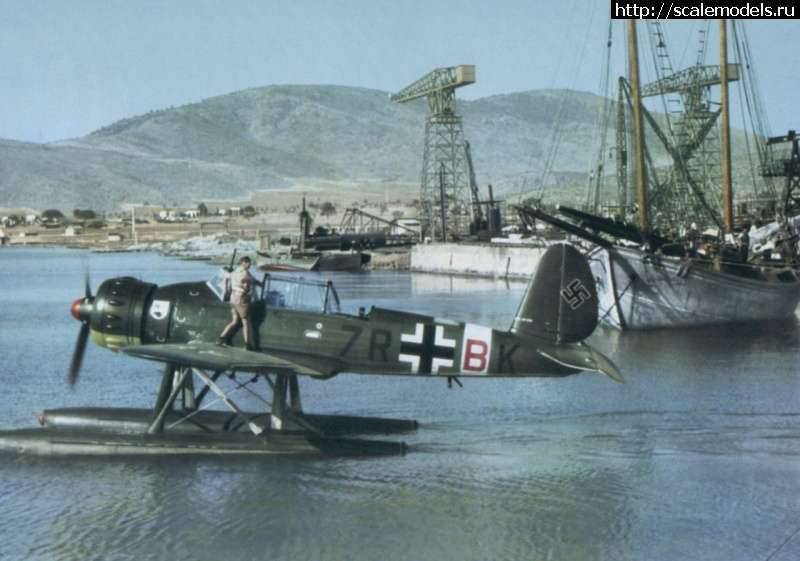
Evaluation of the flight and hydrodynamic qualities of the new aircraft was carried out at the Göttingen Academy of Sciences in August 1937. The designers had to make the final choice between two floats and one. There was no particular difference in aircraft behavior. Each scheme had its advantages and disadvantages. For example, the single-float Arado behaved well when landing on level water, but the take-off was less smooth — supporting wing floats tended to burrow even with a small wave. The double float behaved more smoothly in any conditions, only at high speed the water hit the surface of the stabilizer. But the last defect was eliminated by the correction of the length of the floats, and, as a result, a two-float machine was adopted for mass production.
Made another copy - pre-series Ar-196 M5 with three-bladed propeller and engine BMW 132K power 960 hp, fully consistent with the production aircraft. It was planned to establish several world records among the float aircraft.
The first batch of ten Ag-196-0 was handed over to the Luftwaffe in November 1938. The ceremony took place in Warnemünde. During the first months of 1939, the aircraft underwent troop tests, the results of which showed the need to strengthen some of the fuselage design nodes. Taking into account the wishes of the military, the company from June to December 1939 of the year released the 20 machines of modification A-1 already with devices for fastening to the ship's ejection. At the same time, the aircraft became heavier on 220 kg and began to weigh 3175 kg.
In November, the 1939 of the year began the construction of the 94 Ag-196А-2 aircraft, mostly similar in design to the previous version and differing only in the equipment. The next modification was the Ag-196-4 (24 aircraft). Aircraft of this series did not have built-in weapons.
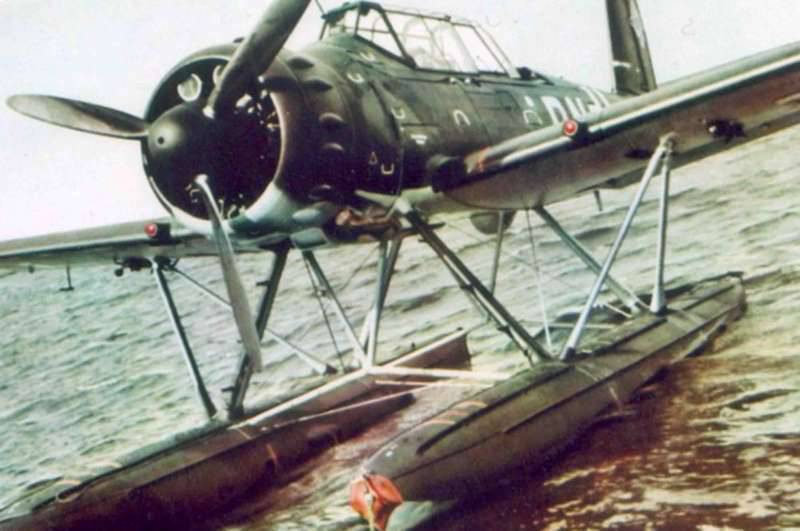
In 1941, the first copies of the most massive modification of the Ag-196-3 (produced: in the 1941 year - 97 aircraft, in the 1942 year - 94, in the 1943 year - 106) were released. The production of the series successfully attracted and the French aircraft factory in St. Nazare. On all A-3 machines, a MG 15 machine gun was installed to protect the rear hemisphere.
The latest serial modification of the Ag-196-5 was built in Holland at the factory of the Fokker company in Amsterdam. On these planes, they changed the composition of the radio-electronic equipment and replaced the defensive machine gun MG 15 with the twin MG 81, with ammunition 2000.
There were projects to further improve the aircraft, but unfavorable for the Germans during the war did not allow them to implement. In total, taking into account the prototypes, the X-NUMX Ag-551 was built.
The first warship to replace the Non-60 with the Ag-196 was, as mentioned above, the “pocket battleship” Admiral Count Spee. During 1939, the rest of the first-line ships re-armed themselves: the Deutschland (later renamed the Lutz), the Scharnhorst, the Gneisenau, the Admiral Scheer and the Prince Eugen.
By the beginning of the Second World War, there was only one combat unit, which was armed with the Ag-196A seaplane; this was a detachment of 1./Bfl.St.196 ship reconnaissance aircraft. In the autumn of 1939, another unit was formed - the squadron 5./Bfl.St.196. Their Ag-196 were assigned to battleships and cruisers.
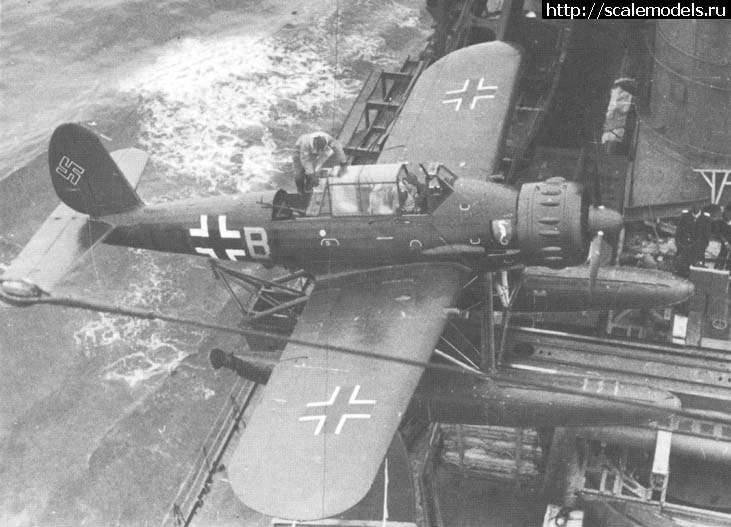
With the beginning of the war, these ships began to act on the communications of the Allies, destroying the ships and convoys on the way. Arado aircraft became their "eyes" and in some cases even air cover. There are cases when scouts from the battleship "Bismarck", using their powerful built-in armament, acted as fighters, attacking single enemy bombers on the high seas. During the war, the Germans often resorted to tricks, putting on the lower surface of the wings and the fuselage of the Ar-196 insignia of the British Air Force (for example, aircraft from the battleship Admiral Earl Spee).
On a relatively large scale, the Arado was first used in the spring of the 1940 of the year during a landing in Norway. "One hundred and ninety-six" conducted reconnaissance and performed anti-submarine patrols. On the eve of Operation Vezeryubung, 8 on April 1940, one of the Ar-196s became a Norwegian trophy - a seaplane from the heavy cruiser Hipper after the exhaustion of the supply of fuel had to splash down at Kristiansund. 12 April this car was overtaken in Andalsnes, where they put the Norwegian identification marks, and then included in the composition of the Air Group of the Romsolal fjord. A week later, the Norwegian Ar-196A flew to the UK. Subsequently, he was included in the 240 squadron of the Royal Air Force, where it was used for testing purposes.
During the landing in Norway, shipboard Ar-196А from German cruisers were actively working. In particular, the hydroplane from the light cruiser Karlsruhe bombed the port facilities in Kristiansund. On the way back to Germany, this car went to the bottom with its cruiser, the victim of the British submarine. Three more Ar-196s sank aboard the heavy cruiser “Blucher” sunk from Oslo, and one aboard the cruiser “Konigsberg” sunk by British dive bombers from Bergen.
One of the most striking operations involving the "one hundred and ninety-six" was the seizure of the British submarine Sil. 5 May 1940 of the year during the patrol flight over the waters of the Kattegat strait Ar-196А discovered this boat, which was in a surface position. The submarine could not escape to the depth due to the damage received from the detonation of its own mine. German pilots fired at the “Forces” from onboard cannons and dropped bombs, forcing the British to stall the course. The commander of the submarine, after weighing the chances of leaving the gulf after detection, decided to surrender. On the submarine raised the corresponding signal. One of the Ar-196A splashed down and took the English captain aboard. After some time, the German ship approached, taking the submarine in tow and delivering it to the occupied Danish Frederikshavn.
In September 1940, the squadron 5./Bfl.St.196 was transferred to French Brest. Based here, the “one hundred and ninety-sixths” provided for the actions of the German submarines. Well-armed, maneuverable and relatively high-speed Ar-196А could effectively resist the British Whitley and Wellington patrol aircraft. As of 1 March 1941, the 5./Bfl.St.196 squad had 20 Аr-196А. At about this level, its number was maintained in the next two years. However, the appearance of British twin-engine fighters Bofaiter and Moskito over the Bay of Biscay forced the transfer of the Arado hydroplanes to reconnaissance tasks, setting off FW-190 aircraft to cover them.
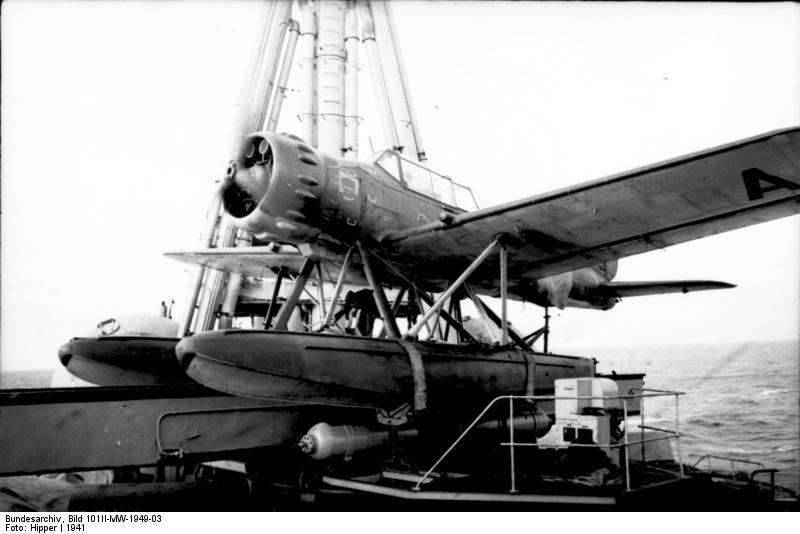
Another region where the Arado was based was Scandinavia. In particular, 25 on August 1940 of the year 1./Bfl.St.196 arrived in Stavanger (Norway), had 15 АR-196А, and on September 15 in Stavanger - 1./Ku.Fl.Gr. 706 with a mixed mix of Ar-196A and Non-115. In October, 1940, in Danish Aalborg, formed a squad of 2./Ku.Fl.Gr. 906, equipped with machines Ar-196A-4 with increased flight range.
The overall losses of the Luftwaffe (combat and non-combat) for the period from September 1 1939 to December 31 1940 amounted to 32 АR-196А.
In April 1941, in preparation for Operation Barbarossa, two new seaplane groups were formed on the Baltic Sea - SAGr. 125 and SAGr. 126, partially armed Ar-196A. Sagr. 126 began fighting in May, operating over the waters of the Mediterranean Sea and based in Greece. As part of this group, the Ar-196A was partially in service with the 2nd detachment, and by the spring of 1942 the 4th detachment equipped with “one hundred and ninety-sixths” arrived in the Mediterranean. It is located on about. Crete. The seaplanes operating over the Aegean Sea were engaged, in particular, in ensuring the passage of oil tankers along the route Bosphorus-Thessaloniki-Athens. Also on the Adriatic was armed Ar-196A detachment 2./Bfl.St.196, whose main task was to fight against the Yugoslav partisan fleet. He dealt with these tasks until the end of May 1944, when the 5 Arado remaining in his team were brought to Denmark.
Group SAGr. 125, armed with Ar-196A during the initial period of the Patriotic War, operated in the Baltic, in the area of the Gulf of Riga. By November 1941, a part of the group was relocated to the Black Sea, and by the spring 1942 of the year - to Greece. After these redeployments in the Baltic and the Black Sea, detached units of 1./Bfl.St.196 and 5./Bfl.St.196 operated, providing cover for convoys and search for submarines. In the second half of 1943, a squadron of 2./SAGr appears in Sevastopol. 125, armed with WU 138 and Ar-196A. Then, right up to the abandonment of the Crimea, there was a detachment of 4./ SAGr. 125. Its main part was brought to Germany, but two or three Ar-196s were left in Romania, hoping to use them to adjust the fire of coastal batteries.
In France, the SAGr group operated in 1943-1944. 128, providing the actions of the German submarines. In August, 1944 was evacuated to Germany and then disbanded. By the autumn of 1944, most of the Ar-196As were concentrated in the Baltic, where they were engaged in supporting the fascist troops trying to gain a foothold in the Baltic States. Along with the aircraft group SAGr. 126, stationed in Pillau (2-th squad) and on about. Rugen (1 units and 3 units), here appear ship vehicles from heavy ships, aimed to support the coastal flank of the Wehrmacht. In particular, the Ar-196А-4 aircraft from the “Lutz” pocket battleship corrected the fire of the ship's artillery that shelled the Soviet positions on the coast of the Gulf of Riga. Three Ar-196A-4s from the heavy Prince Eugen cruiser also performed similar tasks. In addition, the Prince Eugen planes even tried to use as night fighters - to intercept Soviet Y-2.
In 1944, the so-called East Asian Link was based in Penang. It had two Ar-XNUMHA, originally intended for auxiliary cruisers. The main task of this unit was to provide the base of the German submarines in Penang.
A separate chapter in the history of the combat use of the Ar-196 is their service on the raiders. In particular, they took part in the ocean campaigns of the “pocket battleships” “Admiral Graf Spee” (which ended with flooding near La Plata) and “Admiral Scheer”. Ar-196A also participated in the raids of the auxiliary cruisers Orion, Komet, Atlan-tis, Thor, and Michael.
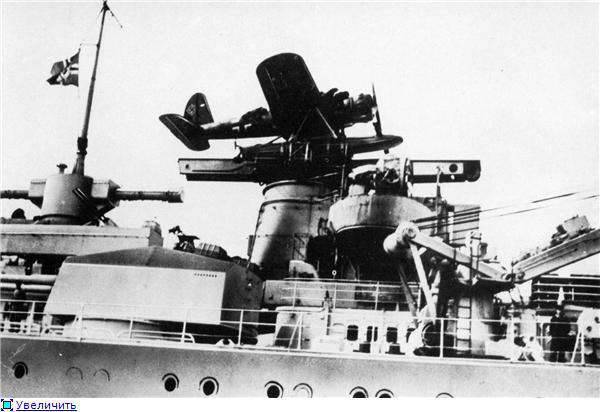
In addition to the German Navy, the Agayo-196 aircraft were in service with two Romanian squadrons on the Black Sea and one squadron of the Bulgarian Coast Guard. The Bulgarian "Arado" patrolled the Black Sea, and were in operation until the early fifties. A couple of interned Ar-196A-3 was used by the Swedes in the F2 flotilla for some time. The Finnish Air Force from the middle of the 1943 of the year to the beginning of the 1944, operated the Ar-196A-2, borrowed from the Germans, to supply its reconnaissance groups operating behind the front line.
Trophy "Arado" were tested in England, and the Soviet Union for quite a long time used several such machines as part of naval aviation and border troops. In 1951, in our country, a modernized version of the Arado, equipped with the ASh-62IR engine, was even tested. Two captured Ar-196А, along with the heavy cruiser Prince Eugen, which came out of the Kriegsmarine section, were delivered to the USA, where they underwent a short test cycle.
Ar-196А was quite a good float plane, which showed itself well as a ship reconnaissance aircraft and coast-based seaplane patrol aircraft. Sufficiently powerful cannon armament gave him the ability to effectively hit small craft, and good flight and maneuverability characteristics - even attack enemy low-speed aircraft.
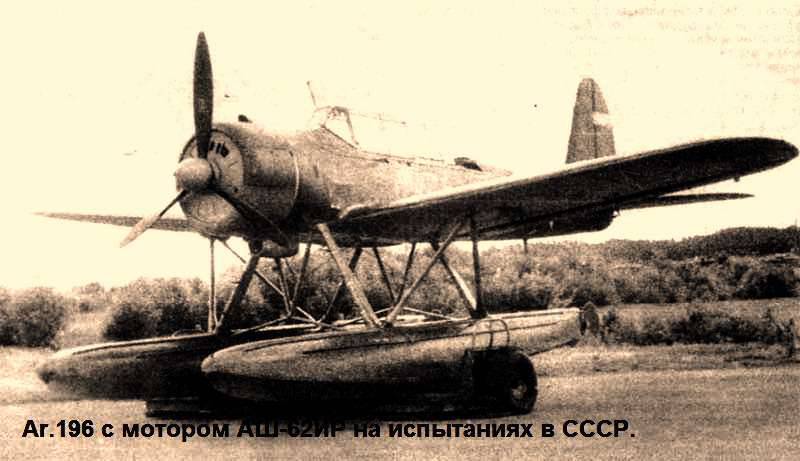
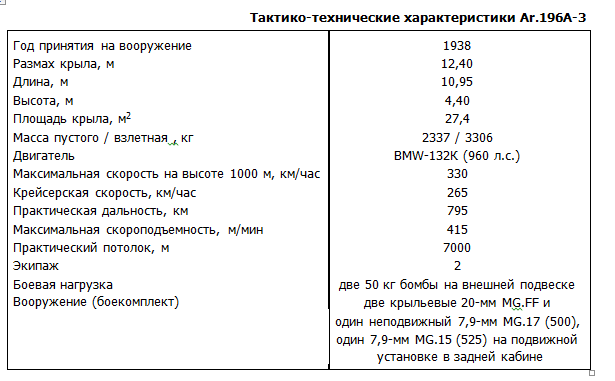
Sources:
Firsov A. Arado Ar.196 // Wings of the Luftwaffe. M.: ONTTI TsAGI, 1994. C. 9-14.
Kolov S. Ship Scout Ar-196. // Wings of the Motherland. 1996. No.2. C. 20-24.
Soyko N. The Soviet version of Ar.196 // Wings of the Motherland. 1996. No.2. C. 24-25.
Chechin A. Shipboard intelligence officer Ar-196. // Model builder. 1998. No.9. C.33-34
Haruk A. All seaplanes of World War II. M.: Yauza. 2014, C.52-56.
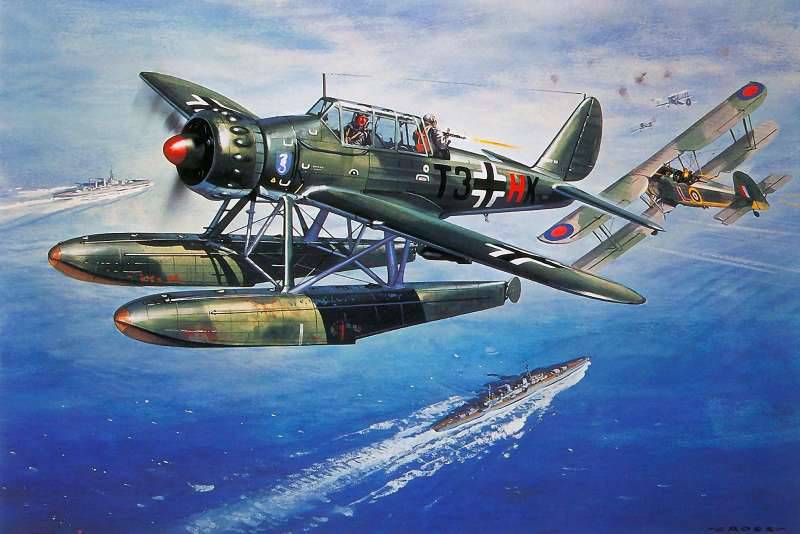
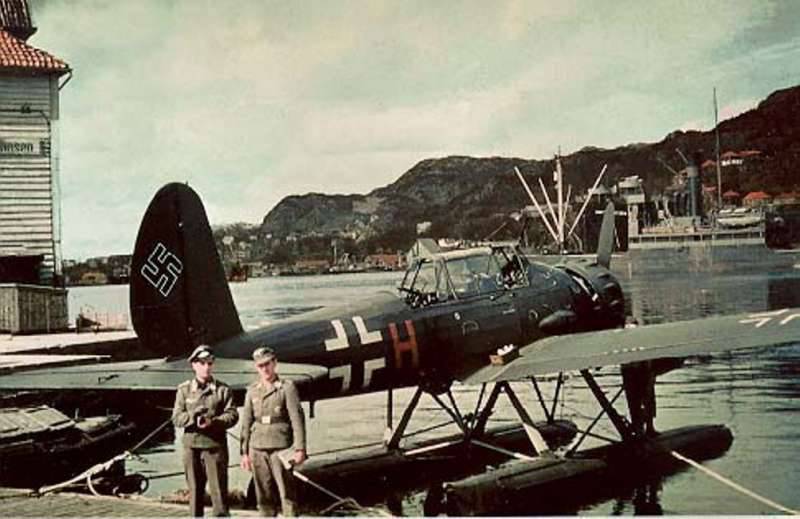
Information